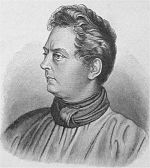- Clemens Brentano
-
Clemens Brentano 
Picture from Meyer's Encyclopedia, 1906Born 9 September 1778
Ehrenbreitstein near Koblenz (today Koblenz-Ehrenbreitstein), GermanyDied 28 July 1842
Aschaffenburg, GermanyOccupation Writer Nationality German Alma mater University of Halle Period Romantic Genres Poetry Notable work(s) Des Knaben Wunderhorn Relative(s) Sister Bettina von Arnim Clemens Brentano, or Klemens Brentano (September 9, 1778 – July 28, 1842) was a German poet and novelist.
Contents
Overview
He was born in Ehrenbreitstein, near Koblenz, Germany. His sister was Bettina von Arnim, Goethe's correspondent. His father's family was of Italian descent. He studied in Halle and Jena, afterwards residing at Heidelberg, Vienna and Berlin. He was close to Wieland, Herder, Goethe, Friedrich Schlegel, Fichte and Tieck.
From 1798 to 1800 Brentano lived in Jena, the first center of the romantic movement. In 1801, he moved to Göttingen, and became a friend of Achim von Arnim. He married Sophie Mereau on 29 October 1803. In 1804, he moved to Heidelberg and worked with Arnim on Zeitungen für Einsiedler and Des Knaben Wunderhorn. After his wife Sophie died in 1806 he married a second time in 1807 to Auguste Busmann. In the years between 1808 and 1818, he lived mostly in Berlin, and from 1819 to 1824 in Dülmen, Westphalia.
In 1818, weary of his somewhat restless and unsettled life, he returned to the practice of the Catholic faith and withdrew to the monastery of Dülmen, where he lived for some years in strict seclusion. He took on there the position of secretary to the Catholic visionary nun, the Blessed Anne Catherine Emmerich, of whom it was said that, during the last twelve years of her life, she could eat no food except Holy Communion, nor take any drink except water, subsisting entirely on the Holy Eucharist. It was claimed that from 1802 until her death, she bore the wounds of the Crown of Thorns, and from 1812, the full stigmata, including a cross over her heart and the wound from the lance. Clemens Brentano made her acquaintance, was converted to the strong faith,[clarification needed] and remained at the foot of the stigmatist's bed copying her dictation without embellishment from 1818-1824. When she died, he prepared an index of the visions and revelations from her journal, The Dolorous Passion of Our Lord Jesus Christ (published 1833). One of these visions made known by Brentano later resulted in the actual identification of the real House of the Virgin Mary in Ephesus by Abbé Julien Gouyet, a French priest, during 1881.
The latter part of his life he spent in Regensburg, Frankfurt and Munich, actively engaged in promoting the Catholic faith. Brentano assisted Ludwig Achim von Arnim, his brother-in-law, in the collection of folk-songs forming Des Knaben Wunderhorn (1805–1808), which Gustav Mahler drew upon for his song cycle. He died in Aschaffenburg.
Brentano, whose early writings were published under the pseudonym Maria, belonged to the Heidelberg group of German romantic writers, and his works are marked by excess of fantastic imagery and by abrupt, bizarre modes of expression. His first published writings were Satiren und poetische Spiele (1800), and a romance Godwi oder Das steinerne Bild der Mutter (1801); of his dramas the best are Ponce de Leon (1804), Victoria (1817) and Die Grundung Prags (1815).
On the whole his finest work is the collection of Romanzen vom Rosenkranz (published posthumously in 1852); his short stories, and more especially the charming Geschichte vom braven Kasperl und dem schönen Annerl (1817), which has been translated into English, were very popular.
Brentano's collected works, edited by his brother Christian, appeared at Frankfurt in 9 vols. (1851–1855). Selections have been edited by J. B. Diel (1873), M. Koch (1892), and J. Dohmke (1893). See J. B. Diel and William Kreiten, Klemens Brentano (2 vols, 1877–1878), the introduction to Koch's edition, and R. Steig, A. von Arnim und K. Brentano (1894).
Cultural references
Brentano's work is referenced in Thomas Mann's novel Doctor Faustus. A cycle of thirteen songs, based on Brentano's poems, is noted in Chapter XXI as one of the composer protagonist's most significant early works.
Poems
- Eingang
- Frühlingsschrei eines Knechtes
- Abendständchen
- Lore Lay
- Auf dem Rhein
- Wiegenlied
- An Sophie Mereau
- Ich wollt ein Sträusslein binden
- Der Spinnerin Lied
- Aus einem kranken Herzen
- Hast du nicht mein Glück gesehen?
- Frühes Lied
- Schwanenlied
- Nachklänge Beethovenscher Musik
- Romanzen vom Rosenkranz
- Einsam will ich untergehn
- Rückblick
References
- Phillips, H. A., "Brentano, Clemens Maria" Cassell's Encyclopedia of World Literature New York: Funk & Wagnalls, 1953.
 Chisholm, Hugh, ed (1911). "Brentano, Klemens". Encyclopædia Britannica (11th ed.). Cambridge University Press.
Chisholm, Hugh, ed (1911). "Brentano, Klemens". Encyclopædia Britannica (11th ed.). Cambridge University Press.
External links
- Works by Clemens Brentano at Project Gutenberg
- Works by Clemens Brentano on Open Library at the Internet Archive
- Catholic Encyclopedia article
Categories:- 1778 births
- 1842 deaths
- Arnim family
- German Roman Catholics
- German writers
- Roman Catholic writers
- German Catholic poets
- Converts to Roman Catholicism
- German people of Italian descent
Wikimedia Foundation. 2010.
